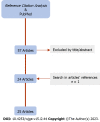Buried bumper syndrome: A critical analysis of endoscopic release techniques
- PMID: 36925650
- PMCID: PMC10011891
- DOI: 10.4253/wjge.v15.i2.44
Buried bumper syndrome: A critical analysis of endoscopic release techniques
Abstract
Buried bumper syndrome (BBS) is the situation in which the internal bumper of the gastrostomy tube, due to prolonged compression of the tissues between the external and the internal bumper, migrates from the gastric lumen into the gastric wall or further, into the tract outside the gastric lumen, ending up anywhere between the stomach mucosa and the surface of the skin. This restricts liquid food from entering the stomach, since the internal opening is obstructed by gastric mucosal overgrowth. We performed a comprehensive search of the PubMed literature to retrieve all the case-reports and case-series referring to BBS and its management, after which we focused on the endoscopic techniques for releasing the internal bumper to re-establish the functionality of the tube. From the "push" and the "push and pull T" techniques to the most sophisticated-using high tech instruments, all 10 published techniques have been critically analysed and the pros and cons presented, in an effort to optimize the criteria of choice based on maximum efficacy and safety.
Keywords: Buried bumper syndrome; Endoscopic release techniques; Percutaneous endoscopic gastrostomy; Review.
©The Author(s) 2023. Published by Baishideng Publishing Group Inc. All rights reserved.
Conflict of interest statement
Conflict-of-interest statement: The informed consent was waived from the patients.
Figures




References
-
- Ma MM, Semlacher EA, Fedorak RN, Lalor EA, Duerksen DR, Sherbaniuk RW, Chalpelsky CE, Sadowski DC. The buried gastrostomy bumper syndrome: prevention and endoscopic approaches to removal. Gastrointest Endosc . 1995;41:505–508. - PubMed
-
- El AZ, Arvanitakis M, Ballarin A, Devière J, Le Moine O, Van Gossum A. Buried bumper syndrome: low incidence and safe endoscopic management. Acta Gastroenterol Belg . 2011;74:312–316. - PubMed
-
- Venu RP, Brown RD, Pastika BJ, Erikson LW Jr. The buried bumper syndrome: a simple management approach in two patients. Gastrointest Endosc . 2002;56:582–584. - PubMed
-
- Cyrany J, Repak R, Douda T, Fejfar T, Rejchrt S. Cannulotome introduced via a percutaneous endoscopic gastrostomy (PEG) tube--new technique for release of a buried bumper. Endoscopy . 2012;44 Suppl 2:E422–E423. - PubMed
-
- Foutch PG, Woods CA, Talbert GA, Sanowski RA. A critical analysis of the Sacks-Vine gastrostomy tube: a review of 120 consecutive procedures. Am J Gastroenterol . 1988;83:812–815. - PubMed
Publication types
LinkOut - more resources
Full Text Sources
Miscellaneous

